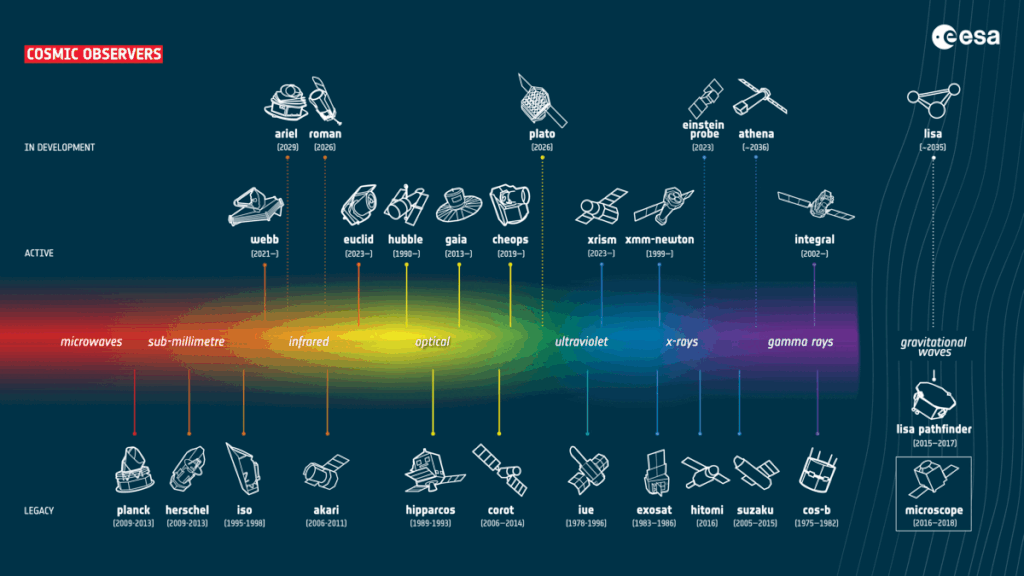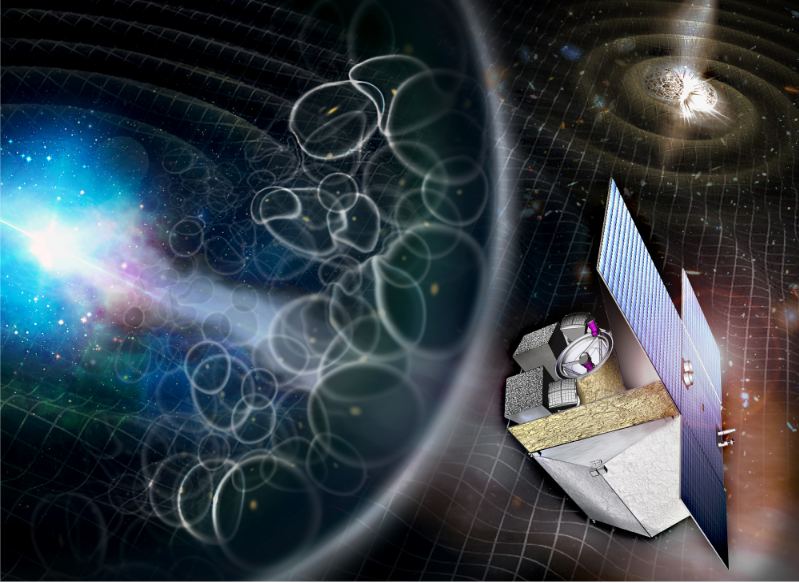The European Space Agency (ESA) is looking to the future and contemplating its next M-class (Medium) mission. These missions are crucial to the ESA Science Programme (part of the agency’s Science Directorate), which aims to provide the best tools to ensure Europe’s continued participation in space exploration and sustain its capabilities in space by fostering innovation, maintaining launch services, and spacecraft operations. The latest round began in December 2021, when the ESA called for proposals for the next M-class mission to launch in the mid-2030s.
In a statement issued yesterday (Wednesday, November 8th), the ESA announced that it had narrowed the list of candidates to three concepts. These include the twin M-MATISSE, the seven-spacecraft Plasma Observatory, and the THESEUS satellite. The final selection will assist ESA operations and research in space by studying the evolution and past habitability of Mars, exploring the plasma environment around Earth, or studying powerful transient events across the Universe. The final selection of one mission is expected to happen by mid-2026.
The ESA’s existing M-class missions cover a wide range of scientific research and objectives, ranging from solar physics and planetary science to investigating cosmological mysteries like Dark Matter and Dark Energy. Examples of recent M-class missions include the Solar Orbiter, the Euclid Observatory, and the Mars Express are examples of flying M-class missions. There are also the PLAnetary Transits and Oscillations of stars (PLATO) and Atmospheric Remote-sensing Infrared Exoplanet Large-survey (ARIEL) space telescopes, which are currently being built and are scheduled to launch in 2029.

The Selection Process
The ESA called for proposals for the seventh round of M-class missions (M7) next-generation M-class mission in December 2021 as part of the ESA’s Cosmic Vision 2015-2025 Programme. From the original 27 submissions, experts within the ESA and partner institutions conducted rigorous scientific and technical assessments and a peer-review selection process to narrow the selections down. By November 2022, five mission concepts remained, which included the three under consideration and the ARRAKIHS and HAYDN proposals.
Whereas the Analysis of Resolved Remnants of Accreted galaxies as a Key Instrument for Halo Surveys (ARRAKIHS) would perform observational tests of the Lambda Cold Dark Matter (LCDM) model, making deep multi-band exposures of ultra-low surface brightness galaxies, enabling detailed and systematic studies of extended galaxy haloes. The High-precision AsteroseismologY in DeNse stellar fields (HAYDN) mission would conduct long-period, high-cadence photometry of dense stellar clusters to learn more about stellar physics and the internal structure of stars. As Carole Mundell, the ESA Director of Science, said in the ESA press release:
“All five mission proposals that went through Phase 0 were excellent – they addressed unique and exciting topics, and were achievable in the mid-2030s timeframe, so it was really difficult to come to a final decision. We established a panel of experts from ESA Member States to review the candidate missions. The reviewers followed a strict selection process, which included looking at science value, scientific feasibility, timeliness and complementarity with other projects.”
Between January and September 2023, these five concepts went through a series of “Phase 0” studies designed to explore the likely scientific returns of each mission and develop preliminary mission designs.
On Wednesday, the ESA Science Programme Committee endorsed the decision to move the three selectees into more detailed “Phase A” studies, which will continue to assess their potential. These are the Mars Magnetosphere ATmosphere Ionosphere and Surface SciencE (M-MATISSE) spacecraft, the Plasma Observatory, and the Transient High-Energy Sky and Early Universe Surveyor (THESEUS) satellite.

For the Phase A studies, each candidate mission will conduct a detailed study assisted by two different aerospace companies, resulting in a more comprehensive design for each mission. “We would like to congratulate all five proposals, each of which showed excellent promise to shed light on unanswered space science questions,” said Cecilia Hernández of AEE (Agencia Espacial Española), Spain, the Chair of the Science Programme Committee. “We look forward to the many discoveries that will be made by the final selected mission.”
The Final Three
Each mission is designed for research that will prove to be of great relevance to scientific programs worldwide. The M-MATISSE mission would consist of two spacecraft equipped with identical instruments studying Mars simultaneously from two different locations in space. The mission aims to investigate how solar wind influences Mars’ atmosphere, ionosphere, and magnetosphere and investigate the impact of these interactions on Mars’ lower atmosphere and surface. Measuring these is key to understanding the evolution of the planet’s atmosphere, climate, and habitability.
The Plasma Observatory is a seven-spacecraft mission that will study the plasma environment (charged solar particles) around Earth. Specifically, the mission will address questions about how particles are energized in space plasmas, what processes dominate energy transport, and what drives interactions between the different regions of Earth’s magnetosphere. The mission will complement the ESA’s current (like the Solar Orbiter) and planned missions examining the interaction of the Sun and Earth to provide more insight into the effects of “space weather” and how it impacts life on our planet.
Rounding out the list is the THESEUS satellite, a multi-instrument mission focusing on high-energy, short-lived events in the cosmos. The main objective will be the study of gamma-ray bursts, the most energetic phenomenon in the Universe, which are attributed to supernovae and the formation of neutron stars and black holes. Specifically, THESEUS will study nearby GRBs to see if they are the counterpart to gravitational waves caused by the merger of neutron stars and black holes. Distant, longer-lived bursts are also of interest because they can help us understand more about the emergence of the first galaxies.

Don’t Forget the L-class!
In addition to the three M-class finalists, the ESA’s Science Programme Committee announced yesterday that it had endorsed a rescoped version of the Advanced Telescope for High-ENergy Astrophysics (ATHENA) telescope, which was selected as an L-class (large) mission in 2014. Originally designed to capture X-ray light to study hot and energetic cosmic phenomena, the “NewAthena” mission is expected to cover a broad range of astrophysics research. The adoption of NewAthena is expected in 2027, with a launch planned for 2037 (shortly after the M-class selectee).
These mission concepts provide a glimpse into the major objectives of what astronomers, space agencies, and related programs hope to accomplish in the coming decade. These include the ongoing study of the Martian environment, how it made the transition from a warmer planet with flowing water to what we see there today, and the search for life (past and present), characterizing the space environment and its impact on Earth; and learning more about the most energetic and mysterious phenomenon in the Universe.
Whichever mission is selected, the scientific returns are to be groundbreaking!
Further Reading: ESA
The post ESA Has a Difficult Choice: Study Mars, Earth's Magnetosphere, or Gamma-Ray Bursts appeared first on Universe Today.
No comments:
Post a Comment